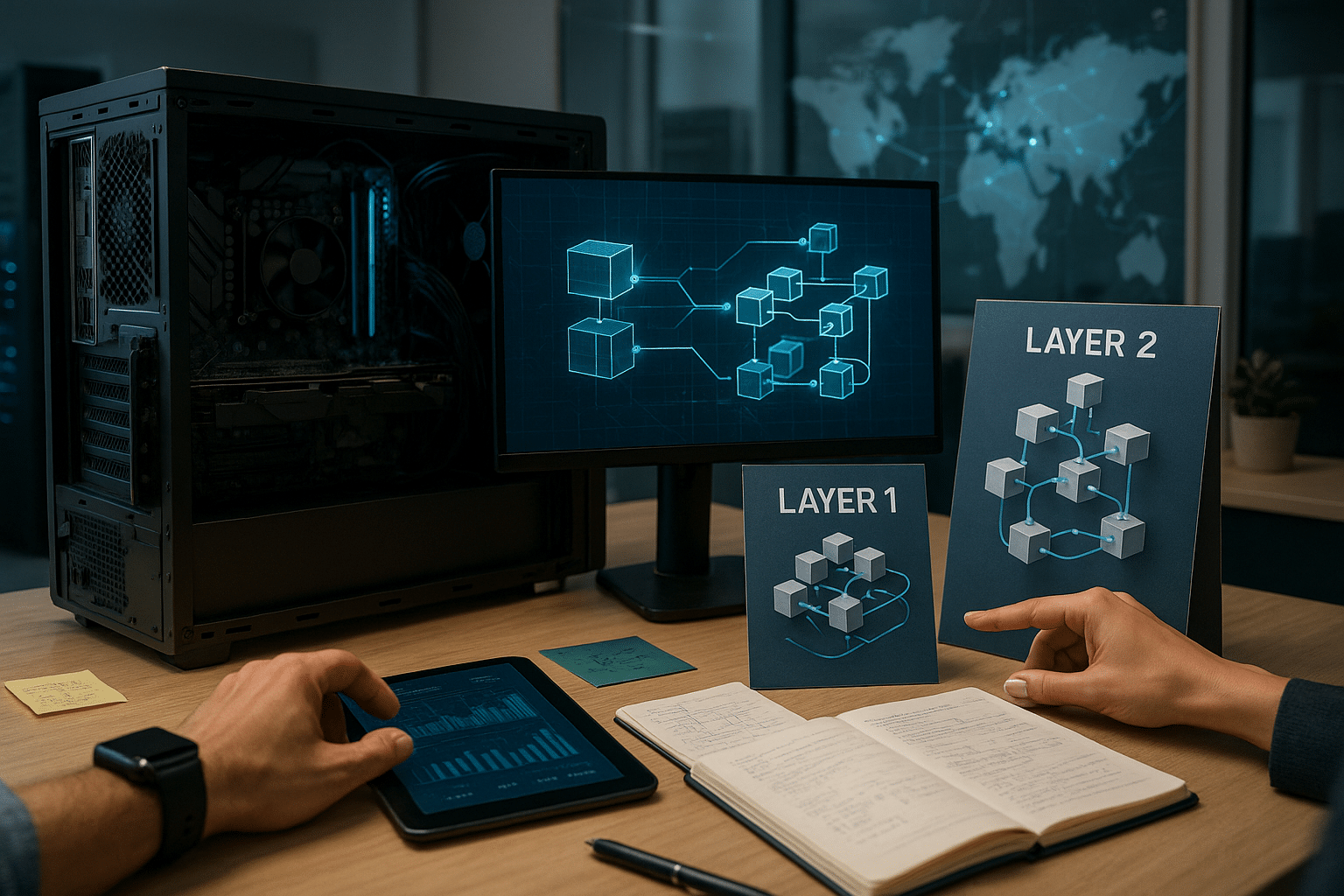But what are these layers? How do they function? And most importantly, what differentiates Layer 1 from Layer 2? Intriguing, isn’t it? 🤔
Well, the crux of this discussion revolves around the fascinating world of blockchain layers. As we delve into the depths of this topic, it is essential to comprehend that the difference between Layer 1 and Layer 2 is not just numerical, it’s more than that – it’s about capability, scalability, and adaptability. So, buckle up, for we are about to embark on an exciting journey of unearthing the mysteries surrounding these layers. 🚀
But before we dive into this ocean of information, let’s take a moment to consider why this knowledge is essential. Blockchain technology, since its inception, has significantly influenced numerous industries. Its potential for disruption and innovation is widely recognized, and this understanding leads us to appreciate the value of comprehending its inner workings – the layers.
The Blockchain – More Than Just a Ledger
Blockchain technology is often misconstrued as a mere ledger for cryptocurrency transactions. However, it’s more than just a transaction log; it’s a decentralized network built on the foundation of trust, security, and transparency. Here is where our protagonists, Layer 1 and Layer 2, come into play. These layers are essentially the building blocks of this vast network. Therefore, understanding the differences between these layers is crucial to fully grasping the scope and potential of blockchain technology.
Peeling Back the Layers
Imagine peeling an onion, one layer at a time. As you peel each layer, you unveil a new facet of the onion, much like the blockchain layers. Each layer presents a new dimension of functionality and complexity. Layer 1 is the underlying blockchain protocol, while Layer 2 is the network built on top of this protocol. The distinctions between these layers are akin to the difference between the foundation of a building and the structure built upon it.
So, are you ready to go on this discovery voyage with me? Prepare to unlock the mysteries of blockchain layers, to delve into the differences between Layer 1 and Layer 2, and to understand the implications of these differences. We will explore the intricacies, compare their strengths and weaknesses, and finally, conclude how these layers collectively shape the future of blockchain technology. 💡
Whether you’re a tech enthusiast eager to enhance your knowledge, a developer seeking to understand the nuances of blockchain, or a business owner contemplating the incorporation of blockchain into your operations, this comprehensive guide will serve as your roadmap. So, fasten your seatbelt as we set forth on this enlightening journey. After all, as Leonardo da Vinci said, “Simplicity is the ultimate sophistication.” Let’s decode the layers of complexity to reveal the simplicity at the heart of blockchain technology.
Decoding the Cryptic: A Deep Dive into Layer 1 and Layer 2 in Blockchain Technology
Are you caught in the crossfire of blockchain terminologies, trying to understand what Layer 1 and Layer 2 mean? Or perhaps, you’re curious about the intricate differences between these two layers? The world of blockchain is indeed filled with complex technicalities. But worry not, in this article, I’m going to unravel these layers and lay bare the stark differences between Layer 1 and Layer 2 in blockchain technology.
To start, let’s establish a fundamental understanding of blockchain. A blockchain is essentially a decentralized and distributed digital ledger that records transactions across many computers. The goal is to ensure that the recorded transactions cannot be altered retroactively, thereby paving the way for a transparent and secure system.
Now, within this system, we encounter Layer 1 and Layer 2, each playing a unique role. Layer 1 refers to the underlying main blockchain architecture. On the other hand, Layer 2 is a secondary framework or protocol built on top of the Layer 1 blockchain. But what does this mean in practical terms? Let’s dive deeper.
Unraveling the Core: A Closer Look at Layer 1
Layer 1, often referred to as the “settlement layer,” is the base layer of a blockchain. It’s the foundational blockchain protocol that defines the network’s operation. In simpler terms, it’s the main freeway where all transactions happen.
Popular blockchain networks like Bitcoin, Ethereum, and Binance Smart Chain are all Layer 1 blockchains. These networks support various applications and tokens on their platform. However, Layer 1 blockchains have their limitations. Scalability is one of the biggest challenges. As more users join the network, the transaction processing speed tends to slow down, leading to a congested network and high fees.
This is where Layer 2 comes into play, addressing these scalability issues. But before we jump into that, let’s compare Layer 1 blockchain networks. Here’s a comparative table that outlines the differences between Bitcoin, Ethereum, and Binance Smart Chain.
| Blockchain Network | Consensus Mechanism | Transaction Speed | Scalability |
|---|---|---|---|
| Bitcoin | Proof of Work (PoW) | 7 transactions/second | Low |
| Ethereum | Proof of Work (PoW) transitioning to Proof of Stake (PoS) | 15-20 transactions/second | Medium |
| Binance Smart Chain | Proof of Staked Authority (PoSA) | 300 transactions/second | High |
For a detailed understanding of these Layer 1 blockchains, watch the video titled “Understanding Blockchain: Layer 1” by the YouTube channel “Simply Explained”.
Scaling the Heights: Introducing Layer 2
With the limitations of Layer 1 in view, Layer 2 solutions were developed to scale blockchain transactions efficiently. Layer 2 solutions are protocols developed on top of the Layer 1 blockchain to offload some work from the main chain. These solutions can take many forms, such as state channels, sidechains, and rollups, each serving to increase transaction speed and reduce fees.
Layer 2 solutions offer a promising solution to the scalability issue. However, it’s important to understand that Layer 2 is not a separate blockchain. It leverages the security and decentralization of the Layer 1 blockchain while providing a faster and cheaper environment for transactions.
Some popular Layer 2 solutions include the Lightning Network for Bitcoin and the Matic Network for Ethereum. To get a clearer understanding of how Layer 2 solutions work, watch the video titled “Understanding Blockchain: Layer 2 Solutions” by the YouTube channel “Simply Explained”.
Layer 1 vs Layer 2: A Comparative Analysis
Now that we have a basic understanding of Layer 1 and Layer 2 in blockchain technology, let’s highlight the key differences between the two.
- Functionality: Layer 1 is the foundational blockchain protocol where all transactions take place. Layer 2, on the other hand, is an overlay network that aims to improve the scalability and efficiency of Layer 1.
- Speed and Fees: Transactions on Layer 1 are relatively slower and costlier due to network congestion. Layer 2 solutions offer faster transactions at lower fees.
- Security: Both layers offer robust security. Layer 1 relies on its consensus mechanism, while Layer 2 leverages the security of the Layer 1 blockchain.
Remember, the aim of Layer 2 solutions is not to replace Layer 1 but to enhance it. Together, they present a unified solution to the scalability and efficiency issues in blockchain technology.
Final Thoughts
The concepts of Layer 1 and Layer 2 in blockchain technology are fundamental to understanding how the ecosystem works. As blockchain technology continues to evolve, so do these layers, with new solutions being developed to address the inherent limitations of the system.
So whether you’re a budding blockchain enthusiast or a seasoned professional, understanding the differences between Layer 1 and Layer 2 is essential in keeping up with the fast-paced world of blockchain technology.
I hope this article has shed light on these layers and the role they play in the blockchain ecosystem. So, delve deeper, explore more, and keep unlocking the layers of blockchain technology!

Conclusion
In conclusion, we have delved into a myriad of crucial points that revolve around the sphere of IT and engineering. Having explored these technical aspects, we can affirm that they are integral to our digital world. They are the pillars that fortify our technological infrastructure, and without them, our progress would come to a standstill.
To recap, we have initially examined the nuances of software engineering, a domain that is central to every application we use daily. It is the art and science of designing and developing software systems that are efficient, reliable, and effective. 💻
Further, we explored the realm of information technology, an industry that is a cornerstone of virtually every business today. It is a diverse field that encompasses various aspects, from managing and processing information to developing and maintaining complex systems.🌐
We also discussed the role of technical writing in bridging the gap between the technical and non-technical world. It is a skill that is becoming increasingly important in today’s tech-heavy world. Clear, concise and comprehensive technical documentation can make the difference between a product’s success and failure.📝
A common thread that links all these areas is the ongoing need for innovation and continual learning. In a rapidly evolving tech landscape, staying current with the latest trends and technologies is not just an advantage – it is a necessity.
By sharing and applying the knowledge gained from this article, you contribute to the broader tech community. The insights provided here are meant not only to inform but also to inspire you to dive deeper into these fascinating fields.
For further reading, I recommend checking out the following resources. The Association for Computing Machinery (ACM) is a leading resource for IT and software engineering professionals. The Internet Engineering Task Force (IETF) is an open international community that develops and promotes voluntary Internet standards.
Remember, every comment, share, and application of this knowledge is a step toward a more informed and connected tech community. So, please feel free to share your thoughts in the comments section below, and don’t hesitate to share this article with your network.
Let’s continue to demystify the complex world of IT and engineering together. 🚀
Sources:
– Association for Computing Machinery (ACM). (n.d.). ACM. Retrieved from https://www.acm.org/
– Internet Engineering Task Force (IETF). (n.d.). IETF. Retrieved from https://www.ietf.org/
Please note that the links provided in this article were active at the time of publication.
#engineering #softwaredevelopment #informationtechnology #technicalwriting



